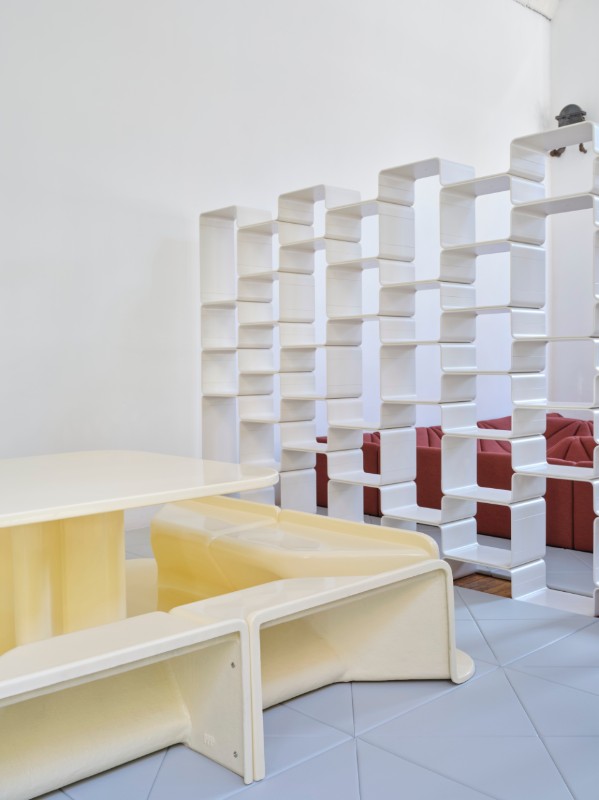Stories like Pierre Paulin’s are almost expected from a land – France – that has accustomed us to design revolutions like the 2CV or the Citröen DS, space-age cars born while anyone else worldwide was still busy reworking pre-war models.
Still, Paulin is a crucial name for modern global design, not just for France, whose spirit of radical innovation, often provocatively pushed beyond the constraints of industry, he was able to embody, anticipate and direct.

We are talking about a designer who, in 1967, became a collaborator of the Mobilier National – the expression of French State in furniture industry, managing furniture in public buildings – to bring radical design straight inside the Elysée Palace, creating the apartment for President Pompidou in 1972. But also, one who knew how to read and steer design trends, creating his own agency, until anticipating and embracing the season of collectible design with a new presidential collaboration, this time for Mitterrand in the 1980s. A both personal and familiar story that coincided with the very history of a discipline and a way of thinking.
From the outset, Paulin's research focused on the body, on the body’s ability to define a customized habitat at any time
There is an affinity between Paulin’s research and that of American artist Donald Judd, the polar star of Minimal Art, and it lies in exploring the potential of the link between technology and the transformation of the human perceptual space: the consecration and concretization of which, for both, is design. A design that, starting from a single idea, developed systems, families of objects with a strong internal consistence (Judd also explored more than abstraction, let us not forget, creating furniture as important as his works of art). This is one of the driving forces that led the Judd Foundation in New York to dedicate an exhibition to Paulin, “Action House”, in the SoHo studio that became a paradigm of 1960s loft living, of regeneration in Manhattan through the reuse and reinterpretation of structures; spaces that have already exhibited the works of names such as Alvar Aalto, Dan Flavin, Felix Gonzalez-Torres and Yayoi Kusama in the last decade.

From the outset, Paulin's research focused on the body, on the body’s ability to define a customized habitat at any time: this was the origin of his Action House project, a 1968 collaboration with American company Herman Miller, designed to extend to the domestic realm the versatility of the Action Office, which the brand had recently launched during the years of George Nelson’s direction. The Action House system is a "family" of modular installations that can be configured by the user even beyond the physical limits imposed by conventional interior design: it would not go into production, to remain in the state of five maquettes, acquired in the Centre Pompidou collection, and three prototypes that Paulin used for his home.
So here come the 25 “slices”, the modules on tetrahedral bases of the Dune system, easy to assemble in a continuous topography to be dedicated to any activity, from relaxing to entertaining; then comes the Déclive, adjustable in inclination, which also questions what is floor and what is seating. Then, the Tapis-Siège, the “rug-seat” which Paulin designed for his Parisian home in 1972 as a project of his own: it is a further step in the exploration of the multiple vocation of surfaces, an experiment in the concept of ground proximity and sharing, typical of the Japanese tatami, interpreted through propped-up folds and upholstered slopes, inviting to sit down.
As far from the idea of a single stand-alone object, as from that of integrated or fixed furniture, Paulin’s concepts for the domestic spaces deconstruct their fundamentals to recompose them into systems that are pure space, apparently abstract, extremely tangible instead, and rooted in the present, their shape and substance being dictated by perception and the body.
Opening image: Tapis-Siège, "Pierre Paulin: Action House", Judd Foundation, New York. Photo Timothy Doyon © Judd Foundation. Donald Judd Art © Judd Foundation/Artists Rights Society (ARS), New York
- Exhibition:
- Pierre Paulin: Action House
- Curators:
- Flavin Judd, Artistic Director of Judd Foundation, and Paulin, Paulin, Paulin.
- Venue :
- Judd Foundation
- Address:
- 101 Spring Street, New York
- Dates:
- until February 15, 2025

Technology and design for innovative washrooms
Fumagalli, a leader in the washroom industry, offers innovative and customizable solutions, combining design, efficiency and sustainability for contemporary and functional environments.










